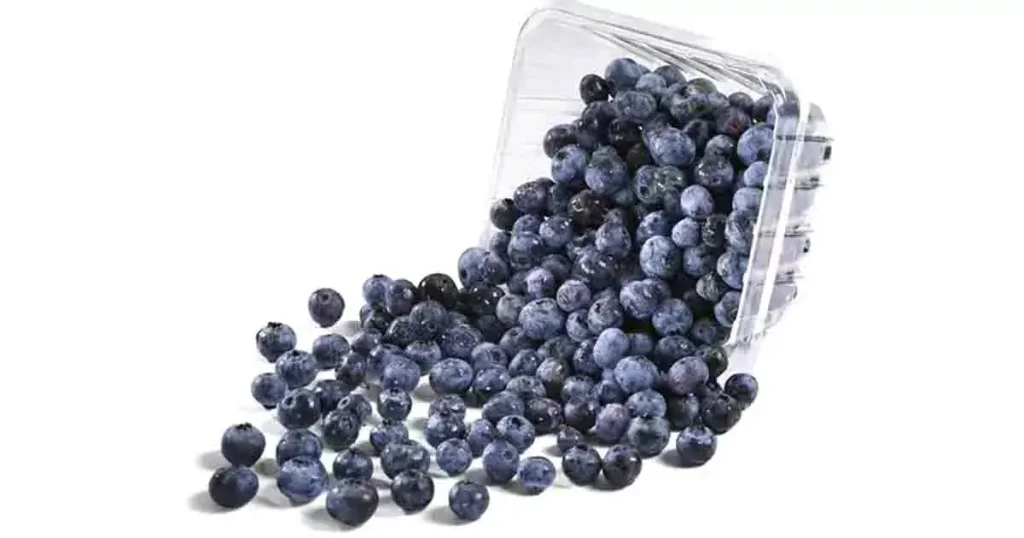Generally, Blueberry comes under the prostrate shrub category, which may grow from 4 inches ( 10 cm ) to 13 feet ( 4 meters ) in height. It is distributed worldwide, and the blueberry tree has purple or blue berries with perennial flowers.
Blueberry comes under the Vaccinium genus and Ericaceae family. The vaccinium genus also consists of Madeira blueberries, cranberries, huckleberries, and bilberries. North America is the native of all the commercial blueberries, including lowbush and highbush ( wild and cultivated ).

Lowbush berries that grow on low-level bushes have small and pea-sized berries, also known as wild blueberries. The blueberry species that can grow taller or be cultivated at a high level is called highbush Blueberry.
The countries which take number one place in producing highbush and lowbush blueberries are the United States and Canada, respectively.
From the article below, you are going to learn all the information about Blueberry, including Blueberry in Telugu, its nutritional value, health benefits of Blueberry, cost, availability, popularity in the local area, and many more.
| English name | Blueberry |
| Telugu name | Fall Sa |
| Order | Ericales |
| Family | Ericaceae |
| Kingdom | Plantae |
| Genus | Vaccinium |
| Clade | Angiosperm / Eudicots / Tracheophytes / Asterids |
Blueberry in Telugu Name
Fall sa is the name of Blueberry in Telugu. Although Blueberry is a widespread and famous name in India, in case you are in a rural or local area of South India or any Telugu-speaking area ( Andhra Pradesh, Telangana, Kerala, some regions of Odisha, Chhattisgarh), perhaps the local people can’t understand the English name.
In that case, you have to ask them for Fall sa. They recognize it immediately. But if you move towards a city area, Blueberry is more famous. The menu of many restaurants includes various blueberry dishes.
Some Products of Blueberry
Click here to Check Some products of Blueberry on amazon.
Health benefits of Blueberry
Blueberries are full of antioxidants, minerals, and vitamins. All these elements provide you with so many notable benefits. Vitamins are vital for blood clotting and responsible for good bone health. Vitamin K, present in blueberries, helps to promote heart health. Some other health benefits of Blueberries are –
1. Blueberries contain high antioxidants
You can consume blueberries as a natural antioxidant source. Antioxidants are not that important to do any functions in the human body. But they help to stop the damage to your body from free radicals. Free radicals are produced by human body cells as wastes.
These wastes will hurt other cells. Consuming blueberries regularly for 10 to 14 days will help your damaged cells recover by 20% or more.
2. Blueberry helps to manage cholesterol levels
If cholesterol builds up in human arteries, it becomes dangerous and can lead to several heart diseases. After building up cholesterol levels, it eventually becomes oxidized.
If the oxidation process happens in massive amounts, it can harm your body. The antioxidant content present in Blueberry helps to control the cholesterol level in the blood and doesn’t allow it to become oxidized.
3. Blueberry helps to control high blood pressure
Regular consumption of Blueberry helps people who suffer from metabolic syndrome by reducing the high blood pressure level. It also keeps an eye on good cardiovascular health. Blueberry helps to relax the muscles, smooth blood flow, and decrease the blood pressure level in blood vessels with the help of nitric oxide produced by the human body ( by consuming Blueberry regularly ).
4. Blueberry helps to control diabetes
Blueberry plays an essential role in managing the blood sugar level of people who are suffering from diabetes. According to so many studies, regular consumption of blueberries helps to boost the sensitivity of insulin levels in type-2 diabetic people. If you are suffering from diabetes, you can also consume blueberries to decrease fasting blood sugar by nearly one-third.
Some photo of Blueberry



Types of Blueberry
In New Jersey, North America, the first Blueberry hybrid cultivar was developed. There is a large number of blueberry varieties present all over the world. But some popular types are given below, which can be suitable for various species and climates. One of the most common and popular varieties of Blueberry cultivated worldwide is the northern highbush Blueberry.
There are five most famous and essential blueberry varieties available. Those are –
1. Highbush Blueberry
Compared to other varieties, highbush is more resistant to diseases. It is one of the self-fertile cultivars. To produce large blueberries, other cultivars can do cross-pollination. You should choose the same type of Blueberry to ensure the largest size and yield. In the case of lowbush and rabbit eye blueberries, they are not self-fertile.
There is a need for different rabbiteye cultivars for the pollination of rabbiteye blueberry. But you will need either a highbush or a lowbush cultivar to pollinate a lowbush blueberry variety.
2. Lowbush Blueberry
Compared to the highbush counterparts, this lowbush blueberry variety is truer and has shorter bushes, as per its name. Generally, it grows under 0.5 meters ( one and a half feet). You should plant numerous cultivars if you want a bountiful lowbush blueberry yield.
According to the recommendation, one should chop the plants back to the ground every 2 to 3 years. But generally, lowbush blueberry plants need little pruning. Top Hat blueberry is a perfect example of a tiny and lowbush variety.
You can use this type of blueberry variety for container gardening and ornamental landscaping. In the USDA zone, the Ruby carpet is one of the well-known lowbush blueberry varieties.
3. Northern highbush Blueberry
The northeastern and eastern United States is the native of northern highbush blueberry plants. This plant can grow up to approximately 1.5 to 2.5 meters ( 5 to 9 feet ) in height. This blueberry variety needs consistent trimming.
Some examples of highbush cultivars are – Rubel, Legacy, Bluecrop, Patriot, Bluegold, Duke, Blu-Ray, Hardyblue, Elliot, and Jersey. All of the above varieties come under USDA hardiness zones.
4. Southern Highbush Blueberry
Florida is the native of this variety of blueberries, and it is a hybrid form of V. Corymbosum. This variety’s average growth is approximately 2 to 2.5 meters or 6 to 8 feet. Southern highbush blueberries need less time for chilling to break flowers and buds. Because of this fact, this variety of blueberries is created to produce berries in mild-winter areas.
If you are in a wintering area and plant this variety of blueberries, the production will be damaged by the frost because these bushes blossom in the last of winter. Some examples of Southern highbush blueberries are – Sunshine Blue, Sharpblue, Ozarkblue, Oneal, Misty, and Golf Coast.
5. Rabbiteye Blueberry
The Southeastern United States is the native of this blueberry variety. The rabbiteye blueberry plant’s growth is approximately 2 to 3 meters or 6 to 10 feet. This variety can blossom in regions with hot and long summers. Compared to northern highbush blueberries, rabbiteye blueberries are much more prone to damage due to winter cold.
There are many older cultivars of this variety are present. Many have more obvious seeds, stone cells, and thicker skins. Some examples of rabbiteye Blueberry are – Brightwell, Tifblue, Climax, Premier, and Powderblue.
6. Half-high Blueberry
If you cross between lowbush Blueberry and northern highbush Blueberry, the result will be half-high Blueberry. The temperature tolerance of this blueberry variety is around 1 to 7 degrees Celsius or 35 to 45 degrees Fahrenheit. It is a medium-sized Blueberry variety that can grow up to 1 meter or 3 to 4 feet tall. It can grow in the ground and containers too.
It needs less trimming as compared to highbush blueberry varieties. Some examples of half-high Blueberry varieties are – Polaries, Patriot, Bluegold, Friendship, Northsky, Northland, and Northcountry.
Nutritional value of Blueberry
The nutritional value you can get from a 100-gram serving of Blueberry, is –
| Energy | 57 kcal |
| Protein | 0.74 grams |
| Fat | 0.33 grams |
| Carbohydrates | 14.49 grams |
| Dietary fibers | 2.4 grams |
| Sugars | 9.96 grams |
| Water | 84 grams |
| Minerals | Quantity | % of the daily value |
|---|---|---|
| Vitamin A | 54 IU | – |
| Vitamin A equivalent | 32 micrograms | 0% |
| beta-Carotene lutein zeaxanthin | 80 micrograms | – |
| Vitamin B1 ( thiamine ) | 0.037 mg | 3% |
| Vitamin B2 ( riboflavin ) | 0.041 mg | 3% |
| Vitamin B3 ( niacin ) | 0.418 mg | 3% |
| Vitamin B5 (pantothenic acid) | 0.124 mg | 2% |
| Vitamin B6 | 0.052 mg | 4% |
| Vitamin B9 ( folate ) | 6 micrograms | 2% |
| Vitamin C | 9.7 mg | 12% |
| Vitamin E | 0.57 mg | 4% |
| Vitamin K | 19.3 micrograms | 18% |
| Minerals | Quantity | % of the daily value |
|---|---|---|
| Zinc | 0.165 mg | 2% |
| Sodium | 1 mg | 0% |
| Potassium | 77 mg | 2% |
| Calcium | 6 mg | 1% |
| Iron | 0.28 mg | 2% |
| Phosphorus | 12 mg | 2% |
| Manganese | 0.336 mg | 16% |
| Magnesium | 6 mg | 2% |
The nutritional content of half cup of blueberry is –
| Sugar | 7 grams |
| Fat | less than 1 gram |
| Calories | 42 |
| Carbohydrates | 11 grams |
| Fibers | 2 grams |
| Protein | 1 gram |
Blueberry contains dietary fibre, vitamins C, K, A, manganese, and antioxidants. It also includes an eye-catching amount of anthocyanin pigments.
Cost of Blueberry in Telugu areas
The cost of Blueberry depends upon its quality, type, packaging ( plastic box, paper box, or wooden box ), form, brand, application, and mainly the place from where you buy it. In India, you can get 1 kg blueberry by spending approximately Rs 500 to Rs 1300. Compared to other Indian fruits, Blueberry is a little expensive.
Because blueberries require specific conditions and time to grow, you should buy them in bulk and prefer online shopping if you want to save your hard-earning money.
Availability and popularity of Blueberry in Telugu area ( Andhra Pradesh, Telangana, Kerala, some regions of Odisha, Chhattisgarh )
In India, you can get Blueberry – a delicate fruit from Himachal Pradesh, Uttar Pradesh, Jammu, and Kashmir. Himachal Pradesh and Shimla region are famous for blueberry harvesting. You can grow blueberries in various range of climates.
But the best weather is warm for the best to thrive. Because of the good harvesting of blueberries in India, there is no deficiency in South India. South India imports blueberries from the harvesting areas and also from foreign countries.
The exotic fruit blueberries have dark berries and have incredible health benefits and nutrition. So most people love to consume blueberries, including Indians and also South Indian people.
Popular recipes for Blueberry in Telugu areas


These delicious fruits can be eaten raw, baked, or cooked. You can use blueberries to prepare jam and also add it with yoghurt. Some popular blueberry dishes are – blueberry smoothies, blueberry milkshakes, blueberry muffins, blueberry cheesecakes, Blueberry and coconut frozen bars, blueberry jam, Blueberry and orange pancakes, blueberry and pretzel cookies, Blueberry and coconut pudding, etc.
Conclusion
Blueberry has a great taste with so many beneficial elements. It has vitamins A, E, choline, folate, manganese, and many more. It helps to keep your heart, mental health, skin, and bones healthy. Although it is a little pricey, people frequently buy and eat blueberries worldwide.
I hope you got all the information about blueberries, including – Blueberry in Telugu, its nutritional value, health benefits of Blueberry, cost, availability, popularity in the local area, and many more.
Frequently asked questions
1. What are the health benefits of blueberries?
1. Blueberry contains high antioxidant
2. Blueberry helps to manage cholesterol levels
3. Blueberry helps to control high blood pressure
4. Blueberry helps to control diabetes
5. High nutrient and low-calorie content is the speciality of blueberries.
6. Blueberries may protect you from cancer.
7. If you suffer from a urinary tract infection, you should take blueberries with advised medicines.
2. What is the suitable climate for growing blueberries?
You can grow blueberries in an extensive range of climates. The best weather for blueberries is the warmer condition or full sun. Suppose you want to grow blueberries in your area. In that case, first, you should consult with the nearest horticulture department and ask them which cultivar is suitable for the climatic condition of your location.
3. What are the varieties of Blueberry?
Blueberry farming includes so many varieties. 3 to 4 harvesting weeks is the period for every cultivar to produce blueberries. There are three types of main Blueberry categories present worldwide. They are – hybrid half-high Blueberry, lowbush, and highbush Blueberry. Some improved blueberry varieties are – Toro, Duke, Elliott, Candler, Legacy, Misty Nelson, Bluejay, Blue Ray, Bluecrop, Poederblue Climax, Oneal, etc.
4. What are the different Indian names of blueberries?
There are so many local names for blueberries in India. Some of them are –
Telugu – Fall sa
Hindi – Nilabadri
Malayalam – Njaval
Marathi – Karvand or Jambhool
Odia – Jamukoli

